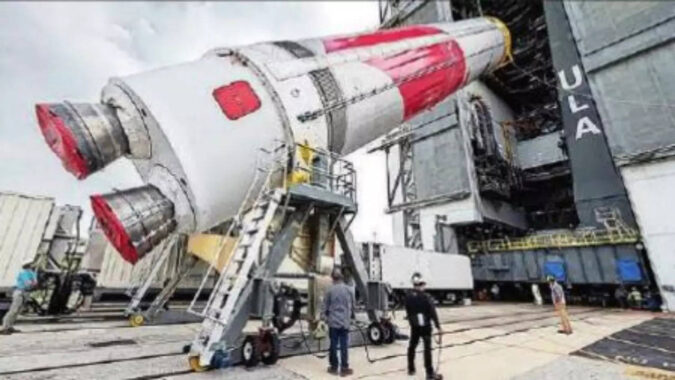Building a rocket is difficult. Preparing a new rocket for its first flight is even more difficult. That has proved true for the Vulcan, a new rocket developed by the United Launch Alliance, a joint venture between Boeing and Lockheed Martin.
The first Vulcan was supposed to launch in May, but a propellant tank cracked during testing in March. Hydrogen leaking from the tank ignited in a fireball, destroying the Vulcan’s upper stage and damaging the test stand.
In a telephone roundtable on Thursday, Tory Bruno, the CEO of the United Launch Alliance, said the problem was now well understood, a fix was in the works and the first Vulcan launch was expected to occur later this year.
In recent years, the business of launching spacecraft and astronauts to orbit has been dominated by SpaceX, the rocket company started and run by Elon Musk. SpaceX’s lower prices and prolific launch rate have been a boon to satellite operators, NASA and the US Space Force. But those customers, especially the Space Force, do not want to rely on one company.
The Space Force is requiring the United Launch Alliance to launch two Vulcan missions before it will be confident using the rocket for spy satellites and other national security payloads. The longer it takes the company to complete the first two missions, the longer it will have to wait for that certification.
A decade ago, United Launch Alliance had a monopoly on national security launches, using its Atlas V and Delta IV rockets, which have had near-flawless flight rockets. But it had almost no commercial customers, because the rockets were expensive.
After SpaceX sued, the military opened the door to certifying SpaceX’s rockets for national security missions. Some in Congress, notably late Senator John McCain, who represented Arizona, increasingly questioned how the US military could rely on the Atlas V because its booster stage was powered by Russian-built RD-180 engines. So far this year, the United Launch Alliance has launched just one rocket, a Delta IV, compared with nearly 50 launched bySpaceX. In 2014, ULA announced the development of the Vulcan to succeed the Atlas V and the Delta IV.
The older rockets are no longer manufactured, and work on the Vulcan is still gearing up. For the Vulcan, instead of relying on Russian engines, ULA turned to Blue Origin, the company started by Amazon founder Jeff Bezos. Blue Origin’s BE-4 engines will power the Vulcan booster, as well as Blue Origin’s own New Glenn rocket, which is still in development.
While the Blue Origin rocket engines used for the first Vulcan rocket passed test firings, an engine slated to be used for the second mission exploded during recent testing. Bruno said that was unlikely to cause any additional delays to the schedule of flights. “This is not unexpected,” Bruno said. “It won’t be the last. And there will be other components on the rocket that also fail acceptance testing. ”
The first Vulcan mission will carry a commercial lunar lander built by Astrobotic Technology of Pittsburgh and two demo satellites for Amazon for its planned Kuiper satellite internet network. NYT
The first Vulcan was supposed to launch in May, but a propellant tank cracked during testing in March. Hydrogen leaking from the tank ignited in a fireball, destroying the Vulcan’s upper stage and damaging the test stand.
In a telephone roundtable on Thursday, Tory Bruno, the CEO of the United Launch Alliance, said the problem was now well understood, a fix was in the works and the first Vulcan launch was expected to occur later this year.
In recent years, the business of launching spacecraft and astronauts to orbit has been dominated by SpaceX, the rocket company started and run by Elon Musk. SpaceX’s lower prices and prolific launch rate have been a boon to satellite operators, NASA and the US Space Force. But those customers, especially the Space Force, do not want to rely on one company.
The Space Force is requiring the United Launch Alliance to launch two Vulcan missions before it will be confident using the rocket for spy satellites and other national security payloads. The longer it takes the company to complete the first two missions, the longer it will have to wait for that certification.
A decade ago, United Launch Alliance had a monopoly on national security launches, using its Atlas V and Delta IV rockets, which have had near-flawless flight rockets. But it had almost no commercial customers, because the rockets were expensive.
After SpaceX sued, the military opened the door to certifying SpaceX’s rockets for national security missions. Some in Congress, notably late Senator John McCain, who represented Arizona, increasingly questioned how the US military could rely on the Atlas V because its booster stage was powered by Russian-built RD-180 engines. So far this year, the United Launch Alliance has launched just one rocket, a Delta IV, compared with nearly 50 launched bySpaceX. In 2014, ULA announced the development of the Vulcan to succeed the Atlas V and the Delta IV.
The older rockets are no longer manufactured, and work on the Vulcan is still gearing up. For the Vulcan, instead of relying on Russian engines, ULA turned to Blue Origin, the company started by Amazon founder Jeff Bezos. Blue Origin’s BE-4 engines will power the Vulcan booster, as well as Blue Origin’s own New Glenn rocket, which is still in development.
While the Blue Origin rocket engines used for the first Vulcan rocket passed test firings, an engine slated to be used for the second mission exploded during recent testing. Bruno said that was unlikely to cause any additional delays to the schedule of flights. “This is not unexpected,” Bruno said. “It won’t be the last. And there will be other components on the rocket that also fail acceptance testing. ”
The first Vulcan mission will carry a commercial lunar lander built by Astrobotic Technology of Pittsburgh and two demo satellites for Amazon for its planned Kuiper satellite internet network. NYT
